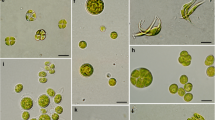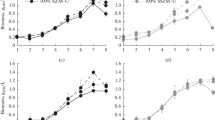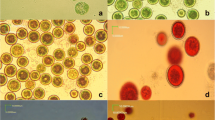Summary
-
1.
Studies have been made on the nutritional characteristics of five members of the class Xanthophyceae: the coccoid forms Botrydiopsis intercedens, Bumilleriopsis brevis, Chlorellidium tetrabotrys and Polyedriella helvetica, and the filamentous form Tribonema minus. In addition, further studies on Monodus subterraneus and Tribonema aequale are reported. A wide range of nutritional types has been found in this class, from obligate phototrophs (Monodus and Polyedriella) to one that assimilated in the dark every organic substrate tested (Bumilleriopsis). The two species of Tribonema proved to be dissimilar with respect to their organic nutrition. Lag phases were exhibited by Bumilleriopsis before the commencement of chemo-organotrophic growth.
-
2.
Good growth of all the above species, except Chlorellidium, which was not examined, was obtained in Miller and Fogg's (1957) standard mineral medium for Monodus. Bumilleriopsis brevis had the highest relative growth constant (0.88 log10/day units at 25°C) and reached the highest cell concentration (978,000 cells/mm3).
-
3.
The obligate phototrophs showed a capacity to remain viable in the dark in mineral medium for long periods (60 days or more) whereas, with the exception of Bumilleriopsis, the facultative chemo-organotrophs remained viable for less than 18 days.
-
4.
Monodus subterraneus, after dark incubation, exhibited a lag period when subcultured before growth began. This phenomenon has been shown to be due to the progressive death of cells in the dark rather than to an adaptation phase.
Similar content being viewed by others
References
Belcher, J. H., and G. E. Fogg: Arch. Mikrobiol. 30, 17 (1958).
Chu, S. P.: J. Ecol. 30, 284 (1942).
Finkle, B. J., D. Appleman and F. K. Fleischer: Science 111, 309 (1950).
Fogg, G. E.: J. exp. Bot. 2, 117 (1951).
Fogg, G. E., and J. D. A. Miller: Verh. int. Ver. Limnol. 13, 892 (1958).
Fogg, G. E., and J. D. A. Miller: Verh. int. Ver. Limnol. 13, 892 (1958).
Fogg, G. E., W. E. E. Smith, and J. D. A. Miller: J. biochem. microbiol. Tech. Engng 1, 59 (1959).
James, E. J.: Beih. bot. Zbl. 53, 519 (1935).
Lewin, J. C.: J. gen. Microbiol. 9, 305 (1953).
Miller, J. D. A., and G. E. Fogg: Arch. Mikrobiol. 28, 1 (1957).
Miller, J. D. A., and G. E. Fogg: Arch. Mikrobiol. 30, 1 (1958).
Neish, A. C.: Canad. J. Bot. 29, 68 (1951).
Pascher, A.: Kryptogamenflora von Deutschland, Österreich und der Schweiz. Leipzig: Akademische Verlagsgesellschaft 1937–1939.
Roach, B. M. Bristol: Ann. Bot. 40, 149 (1926).
Topley, W. W. C., and G. S. Wilson: Principles of Bacteriology and Immunity, 4th Edn, by G. S. Wilson and A. A. Miles, vol. 1. London: Edward Arnold 1955.
Waksman, S. A.: In Handbuch der biologischen Arbeitsmethoden, Ed. E. Abderhalden. Abt. 11, Teil 3, 715. Berlin: Urban & Schwarzenberg 1928.
Woodhead, N., and R. D. Tweed: Northw. Nat. 210 (1955).
Author information
Authors and Affiliations
Additional information
Present address: Freshwater Biological Association, The Ferry House, Far Sawrey, Ambleside, Westmorland.
Rights and permissions
About this article
Cite this article
Belcher, J.H., Miller, J.D.A. Studies on the growth of Xanthophyceae in pure culture. Archiv für Mikrobiologie 36, 219–228 (1960). https://doi.org/10.1007/BF00410163
Received:
Issue Date:
DOI: https://doi.org/10.1007/BF00410163




